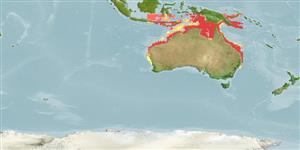>
Carangaria/misc (Various families in series Carangaria) >
Polynemidae (Threadfins)
Etymology: Polydactylus: Greek, poly = a lot of + greek, daktylos = finger (Ref. 45335).
More on author: Günther.
Environment: milieu / climate zone / depth range / distribution range
Ökologie
seewasser; brackwasser demersal; tiefenbereich 10 - 56 m (Ref. 45356), usually 10 - 56 m (Ref. 45356). Tropical; 4°S - 34°S, 113°E - 154°E (Ref. 57343)
Eastern Indian Ocean and Western Pacific: known only from southern Indonesia (Timor and Arafura seas) and northern Australia (Exmouth Gulf, Western Australia to Clarence River, New South Wales) (Ref. 9685). The type locality (China) may most likely be erroneous.
Size / Gewicht / Alter
Maturity: Lm ? range ? - ? cm
Max length : 21.0 cm FL Männchen/unbestimmt; (Ref. 1844); 24.5 cm FL (female)
Inhabits coastal waters over sand or mud bottoms. Feeds on prawns. Often taken in association with Penaeus prawns in the Gulf of Carpentaria.
Life cycle and mating behavior
Geschlechtsreife | Fortpflanzung | Ablaichen | Eier | Fecundity | Larven
Sex change occurs between 12-14 cm SL (Ref. 45356).
Motomura, H., 2004. Threadfins of the world (Family Polynemidae). An annotated and illustrated catalogue of polynemid species known to date. FAO Spec. Cat. Fish. Purp. Rome: FAO. 3:117 p. (Ref. 57343)
IUCN Rote Liste Status (Ref. 130435)
Bedrohung für Menschen
Harmless
Nutzung durch Menschen
Fischereien: nicht kommerziell
Mehr Information
ReferenzenAquakulturAquakultur ProfilZuchtlinienGenetikElectrophoresesVererbbarkeitKrankheitenVerarbeitungNutrientsMass conversion
Tools
Zusatzinformationen
Download XML
Internet Quellen
Estimates based on models
Preferred temperature (Ref.
123201): 25.4 - 28.7, mean 27.7 °C (based on 632 cells).
Phylogenetic diversity index (Ref.
82804): PD
50 = 0.5000 [Uniqueness, from 0.5 = low to 2.0 = high].
Bayesian length-weight: a=0.00813 (0.00477 - 0.01384), b=3.11 (2.96 - 3.26), in cm total length, based on LWR estimates for this species & Genus-body shape (Ref.
93245).
Trophic level (Ref.
69278): 3.1 ±0.30 se; based on food items.
Widerstandsfähigkeit (Ref.
120179): mittel, Verdopplung der Population dauert 1,4 - 4,4 Jahre. (K=0.16).
Fishing Vulnerability (Ref.
59153): Low vulnerability (17 of 100).
